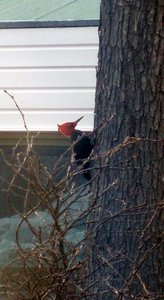Advertisement
Published: September 30th 2008

 Carpintero Negro
Carpintero Negro
Magellanic Woodpecker: ...gewoon bij ons hotel Lago GreyVandaag weer een dag van reizen: we vertrekken uit ons hotel Lago Grey en rijden naar Punta Arenas, zo’n 400 km zuidelijker. Het landschap verandert langzaam; van hoge bergen met sneeuwwitte toppen en bergmeren in pampa’s, uitgestrekte velden met aan de horizon de bergen. Aangezien we eerst uit het nationaal park Torres del Paine moeten rijden via de omweg doen we over deze 400 km zo’n 6 uur… Weer een lange zit, maar dan zijn we toch rond half 4 bij ons hostel in Punta Arenas: hostel Carpa Manzano. Na NP Torres del Paine lijkt Punta Arenas wel een industriestad: veel huizen, drukke straten, veel verkeer, veel industrie (en helaas ook de rook die boven de stad hangt) en boten met haventje.
Eigenlijk wilden we onderweg nog naar de pinguïn kolonie bij Seno Otway, maar helaas… we hadden al gehoord dat het nu niet het seizoen is… dus maar doorgereden naar Punta Arenas zelf.
Nadat we zijn gearriveerd, lopen we een rondje door het centrum van Punta Arenas, voordat we een pizza eten bij Dino’s.
Op tijd slapen want morgen rijden we het langste stuk op 1 dag in deze vakantie…
Lonely planet:
Punta Arenas: population 125.000
Punta Arenas

 Carancho - Traro
Carancho - Traro
Crested caracara: ....nest bouwenhas a few attractions of its own - mostly museums, cultural spots and nearby penguin colonies - but it really serves as the transportation hub and departure point for Tierra del Fuego and Puerto Natales (the gateway toParque Nacional Torres del Paine)
Little more than 150 years old, Punta Arenas was originally a military garrison and penal settlement that later proved to be conveniently situated for ships headed to California during the gold rush. Compared to the initial Chilean settlement at Fuerte Bulnes, 60km south, the town had a better, more protected harbour, and superior access to wood and water.
During its early years Punta Arenas’ economy depended on wild animal products, including sealskins, guanaco hides and feathers, mineral products (including coal and gold), and guano, timber and firewood. None of these was a truly major industry, and the economy didn’t take off until the last quarter of the 19th century after the territorial governor authorized the purchase of 300 purebred sheep from the Falkland Islands. This successful experiment encouraged others to invest in sheep and, by the turn of the century, nearly two million animals grazed the territory.
Advertisement
Tot: 0.156s; Tpl: 0.01s; cc: 13; qc: 66; dbt: 0.0721s; 1; m:domysql w:travelblog (10.17.0.13); sld: 1;
; mem: 1.1mb

 Carpintero Negro
Carpintero Negro
 Carancho - Traro
Carancho - Traro